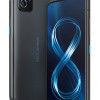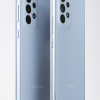Camera Phone Shoot-Out
As I mentioned at the beginning, Japan is the epicenter of the camera phone phenomenon, and a leader in camera phone technology. Therefore, it shouldn't be any surprise that, of the four phones, the Japanese phone - the Sanyo 5300 - pretty much blew away the competition.
The 5300 is based heavily on the Sanyo A3015SA, a phone that was introduced in Japan just a few months before the 5300 made its debut in the U.S. This unusually short lag time is part of the reason the 5300 is arguably the most advanced cell phone available in the U.S. today (wireless PDAs and smartphones aside).
Its pictures were among the best of the four. You won't mistake them for photos from a full-fledged digital camera, but it came closer than any of the other phones. The lack of true whites is a knock against it, but the pictures still looked good, and a few seconds in Photoshop can fix the problem (Sprint's online tools aren't much help).
What really puts the Sanyo ahead of the pack though, are the advanced features. The flash, low-light capability, digital zoom, and manual controls are all impressive, useful features. The handy photo wallet concept and tight integration with Sprint's photo service make working with pictures a joy. And last but not least, the beautiful main display and great external color display are simply top-notch.
The drawbacks are its price, size, and battery life. But if you want the absolute latest in technology or see yourself taking a lot of pictures, the Sanyo 5300 is your phone.
For those who prefer something smaller and more stylish, while keeping a powerful feature set and good color display, the Nokia 7210 and Samsung A500 are both excellent choices.
The Samsung's camera is more convenient for snapping quick photos, although it's not as convenient to carry. Sprint's upload-all function is also better for those who like to take a lot pictures for themselves. And for those who simply prefer Sprint's album-based photo service, the Samsung may be the better choice of the two. Its futuristic looks and advanced features sweeten the deal.
Nokia devotees, meanwhile, will not be disappointed with the 7210. Its slim profile, custom faceplates, and unique styling are sure to make an impression. Its menus and voice quality are excellent, and the speakerphone is very handy and works well.
I wouldn't recommend the Nokia camera for serious picture-taking, but it will do the trick for those unexpected "I wish I had camera" moments, especially if you plan to wear the camera as a headset. The MMS features are also fairly well-implemented. (Just make sure you have the latest software.)
Finally, for those who prefer a more business-like phone, the Motorola T720i performed extremely well. The design is a bit more conservative than the others, but also more masculine, a consideration for some. In a similar vein, the Motorola included more and better non-musical ringtones than the others, an important consideration for business users.
The camera produced smaller photos than the rest, with less color saturation, but it did perform quite well in difficult lighting situations. The only really major drawback is how photos look on the phone's display. Fortunately, the Motorola's ability to send a picture right after capture will help you quickly get those pictures off the phone, to a better display.
Where the Motorola really shines is in its non-camera performance. The top-notch voice quality, ergonomics, and interface make it the perfect choice for those who value the basics over flashy features, but still want the camera option for occasional use.
Future Phones
All four manufacturers have plans for more new camera phones in 2003.
Nokia has already announced the 3650, an advanced phone with built-in camera, as well as the 7250, a phone similar to the 7210, but with a built-in camera. The 3650 should be out in the U.S. in early 2003, and promises better picture quality and improved MMS integration compared to the 7210.
Motorola spokesperson Julie Cordua indicated that Motorola is also planning additional camera phones for 2003, including both camera-accessory and built-in camera models.
Samsung just this week started shipping the new SGH-V205 for T-Mobile, a phone with a 65,000-color display, MMS, and a built-in swivel camera. The company has also announced the SGH-P400 and SPH-A600, both variations on Samsung's "RCP" Rotating Camera Phone design, which features a swivel camera and rotating display.
Sanyo is tight-lipped about its plans for 2003, but continues to churn out impressive new models in Japan, including models with dual color displays AND dual cameras (internal and external).
Additional camera phones are expected from Audiovox, LG, Siemens, and others. All of the national carriers have major plans for camera phones in 2003.
Future Features
After working with these phones for a few weeks of heavy use, there were a few features I found myself wanting. First, the thumbnail views are very helpful. The Nokia and Sanyo had this, although the Sanyo only offered thumbnails for the wallet, not the inbox. Not having a thumbnail view is almost like not being able to see a list of names in your phone book. It's an essential feature.
Another feature I think would help tremendously is the ability to zoom in on captured photos - to view fine details, faces in a group shot, etc. Most digital cameras have this. It would be especially useful for checking for blurring. This is especially an issue in low light, where the slightest hand movement can ruin a photo. Even major blurring sometimes isn't apparent when the image is scaled down to a tiny phone display.
Also, the ability to rotate photos after they've been taken would be very helpful. Again, this is a feature found on many digital cameras. This would let you take portrait shots (or landscape, in the case of the Sanyo) and still send the photo right side up.
Finally, while 640x480 is a pretty good resolution for this type of device, the race is already on to release the first 1.3 megapixel camera phone. Several manufacturers and carriers in Japan have already announced plans for 1.3 megapixel camera phones to be released in the next few months. This is pretty exciting, because it really makes the camera phone a true convergence device - a replacement for both your old phone and your digital camera.
Future Services
On the service side, I think Sprint's upload-all feature and online photo albums are great ideas, well implemented. I'd like to see something similar for MMS. I don't think it would be too hard to create a feature that would let you automate sending a batch of photos via MMS, to avoid having to manually send each one. Also, I don't see why carriers couldn't set up a special phone number or e-mail address that would receive MMS photos and make them available on the web.
Two major trends are set to follow closely on the heels of camera phones. The first is MMS interoperability. The carriers learned their lesson from text messaging (which only took off after interoperability was added) and are all planning on supporting interoperability for photo messaging. Even Sprint PCS plans to link its proprietary system with other carriers' MMS systems.
The second major trend is video. The Nokia 3650 may be first out of the gate with this feature, and will raise the MMS size limit to 100k, to allow for short video messages. All of the major carriers are also planning network upgrades to double or triple data speeds in 2003 and 2004. The desire to offer video services is one of the driving factors behind these upgrades.
Something newer and better is always right around the corner, and next year's camera phones will certainly improve on this year's models. The phones reviewed here are the very first of a kind, and in some cases, the first-generation status is apparent. But looking at the big picture, the simple mobile phone is quickly becoming an all-purpose multimedia communcation device. These cutting-edge phones offer a tantalizing glimpse of that future, that you can hold in your hand today.


 iPhone 14 Plus Offers a Big Screen For Less
iPhone 14 Plus Offers a Big Screen For Less
 iPhone 15 Series Goes All-In on USB-C and Dynamic Island
iPhone 15 Series Goes All-In on USB-C and Dynamic Island
 Asus Zenfone 8 is a Compact Flagship
Asus Zenfone 8 is a Compact Flagship
 iPhone 13 Upgrades Cameras, Displays
iPhone 13 Upgrades Cameras, Displays
 Samsung Galaxy A53 Coming to US in Two Weeks
Samsung Galaxy A53 Coming to US in Two Weeks

